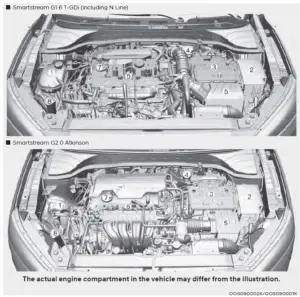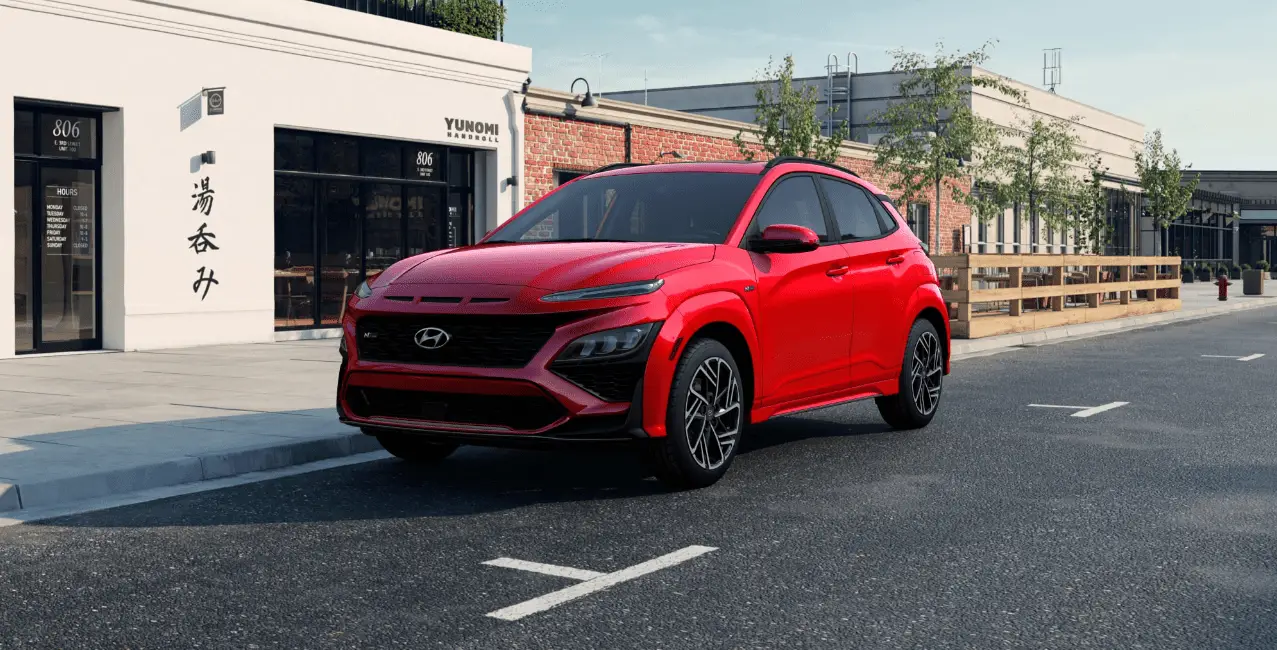Hyundai Kona 2023 Engine Compartment and Owner Maintenance
The engine compartment of the 2023 Hyundai Kona is a conveniently located, easily accessible area intended for effective maintenance. The ease with which normal maintenance chores like changing the oil, checking fluid levels, and examining belts and hoses may be completed would be appreciated by the owners. Hyundai’s dedication to owner maintenance is demonstrated by the easily identifiable labels and convenient positioning of crucial parts, enabling owners to actively contribute to maintaining the longevity and performance of their cars. The 2023 Hyundai Kona promotes dependability and peace of mind over the course of its lifecycle by encouraging owners to remain involved in the maintenance of their vehicles through its user-friendly design and meticulous attention to detail.
2023 Hyundai KONA Specs, Price, Features, Milage (Brochure)
Engine Compartment

- Engine coolant reservoir /Engine coolant cap
- Fuse box
- Battery
- Brake fluid reservoir
- Air cleaner
- Engine oil dipstick
- Engine oil filler cap
- Windshield washer fluid reservoir
Maintenance Services
You should exercise the utmost care to prevent damage to your vehicle and injury to yourself whenever performing any maintenance or inspection procedures. Have your vehicle maintained and repaired by an authorized HYUNDAI dealer. An authorized HYUNDAI dealer meets HYUNDAI’s high service quality standards and receives technical support from HYUNDAI in order to provide you with a high level of service satisfaction.
Owner’s Responsibility
Maintenance service and record retention are the owner’s responsibility. You should retain documents that show proper maintenance has been performed on your vehicle in accordance with the scheduled maintenance service charts shown on the following pages. You need this information to establish your compliance with the servicing and maintenance requirements of your vehicle warranties. Detailed warranty information is provided in your Owner’s Handbook & Warranty Information booklet. Repairs and adjustments required as a result of improper maintenance or a lack of required maintenance are not covered.
Owner Maintenance Precautions
Inadequate, incomplete or insufficient servicing may result in operational problems with your vehicle that could lead to vehicle damage, an accident, or personal injury. This chapter provides instructions only for the maintenance items that are easy to perform. Your vehicle should not be modified in any way. Such modifications may adversely affect the performance, safety or durability of your vehicle and may, in addition, violate conditions of the limited warranties covering the vehicle.
NOTICE
Improper owner maintenance during the warranty period may affect warranty coverage. For details, read the Owner’s Handbook & Warranty Information booklet provided with the vehicle. If you’re unsure about any servicing or maintenance procedure, have the system be serviced by an authorized HYUNDAI dealer.
Owner Maintenance
WARNING
Performing maintenance work on a vehicle can be dangerous. If you lack sufficient knowledge and experience or the proper tools and equipment to do the work, have it done by an authorized HYUNDAI dealer?
ALWAYS follow these precautions for performing maintenance work:
- Park your vehicle on level ground. Shift the vehicle to P (Park), apply the parking brake, and press the Engine Start/Stop button to the OFF position.
- Block the tires (front and back) to prevent the vehicle from moving. Remove loose clothing or jewelry that can become entangled in moving parts.
- If you must run the engine during maintenance, do so in an outdoor area or in an area with plenty of ventilation.
- Keep flames, sparks, or smoking materials away from the battery and fuel-related parts.
WARNING
Touching metal parts
Do not touch metal parts (including strut bars) while the engine is operating or hot. Doing so could result in serious personal injury. Turn the engine off and wait until the metal parts cool down to perform maintenance work on the vehicle. The following lists are vehicle checks and inspections that should be performed by the owner or an authorized HYUNDAI dealer at the frequencies indicated to help ensure safe, dependable operation of your vehicle. Any adverse conditions should be brought to the attention of your dealer as soon as possible. These Owner Maintenance vehicle checks are generally not covered by warranties and you may be charged for labor, parts and lubricants used.
Owner Maintenance Schedule
When you stop for fuel:
- Check the coolant level in the engine coolant reservoir or the water-cooled intercooler coolant reservoir.
- Check the windshield washer fluid level.
- Check for low or under-inflated tires.
WARNING
Be careful when checking your coolant level if the engine is hot. This may result in coolant being blown out of the opening and cause serious burns and other injuries.
While operating your vehicle:
- Note any changes in the sound of the exhaust or any smell of exhaust fumes in the vehicle.
- Check for vibrations in the steering wheel. Notice if there is any increased steering effort or looseness in the steering wheel, or change in its straight-ahead position.
- Notice if your vehicle constantly turns slightly or “pulls” to one side when traveling on smooth, level road.
- When stopping, listen and check for unusual sounds, pulling to one side, increased brake pedal travel or “hard-to-push” brake pedal.
- If any slipping or changes in the operation of your transmission occurs, check the transmission fluid level.
- Check the automatic transmission P (Park) function.
- Check the parking brake.
- Check for fluid leaks under your vehicle (water dripping from the air conditioning system during or after use is normal).
At least monthly:
- Check the coolant level in the engine coolant reservoir.
- Check the operation of all exterior lights, including the stoplights, turn signals, and hazard warning flashers.
- Check the inflation pressures of all tires including the spare for tires that are worn, show uneven wear, or are damaged.
- Check for loose wheel lug nuts.
At least twice a year: (for example, every Spring and Autumn)
- Check the radiator, heater, and air conditioning hoses for leaks or damage.
- Check windshield washer spray and wiper operation. Clean wiper blades with a clean cloth dampened with washer fluid.
- Check headlight alignment.
- Check the muffler, exhaust pipes, shields, and clamps.
- Check the seat belts for wear and function.
At least once a year:
- Clean body and door drain holes.
- Lubricate door hinges and hood hinges.
- Lubricate door and hood locks and latches.
- Lubricate door rubber weather strips.
- Check the air conditioning system.
- Inspect and lubricate automatic transmission linkage and controls.
- Clean the battery and terminals.
- Check the brake fluid level.
FAQ
Key fluids to check include engine oil, coolant, brake fluid, power steering fluid, and windshield washer fluid.
The recommended oil change interval can vary based on factors such as driving conditions and engine type. Refer to the owner’s manual for specific guidance.
Yes, most owners can check and top up engine oil themselves using the dipstick and appropriate oil type recommended in the owner’s manual.
The recommended maintenance schedule can typically be found in the owner’s manual provided with the vehicle.
Inspect belts and hoses for signs of wear, cracks, or leaks regularly, and replace them if any issues are detected.
The engine air filter should be checked at regular intervals and replaced as needed, often as part of routine maintenance.
Owners should always follow safety precautions outlined in the owner’s manual, such as disconnecting the battery when necessary and allowing the engine to cool before performing maintenance.
Some owners may have the skills and tools to perform more advanced tasks, but it’s advisable to consult a qualified technician for such procedures to ensure proper execution.
Using the appropriate tools and equipment, such as a torque wrench, can be crucial to ensure that maintenance tasks are done correctly.
Regularly checking and maintaining proper tire pressure, ensuring a clean air filter, and using the recommended motor oil can contribute to better fuel efficiency.
Typically, there is a hood release lever inside the vehicle, usually located near the driver’s side footwell. After releasing the hood, it can be opened from the front of the vehicle.
Many routine maintenance tasks, such as checking fluid levels, can be performed by owners with basic automotive knowledge. However, more complex tasks may require professional service.
Extreme weather conditions, such as extreme cold or heat, can affect vehicle components. It’s essential to follow the manufacturer’s recommendations and adjust maintenance as needed based on the climate.
Hyundai often provides resources such as owner’s manuals and online guides to assist owners in understanding and performing maintenance tasks.
The 2023 Hyundai Kona typically comes with a manufacturer’s warranty that covers certain engine-related components for a specific period. The warranty details can vary, so it’s essential to review the warranty documentation for specifics.
Useful Link
View Full User Guide: Hyundai Kona 2023 User Guide
Download Manuals: https://owners.hyundaiusa.com/us/en/resources/manuals-warranties.html
2023 Hyundai KONA Specs, Price, Features, Milage (Brochure)


